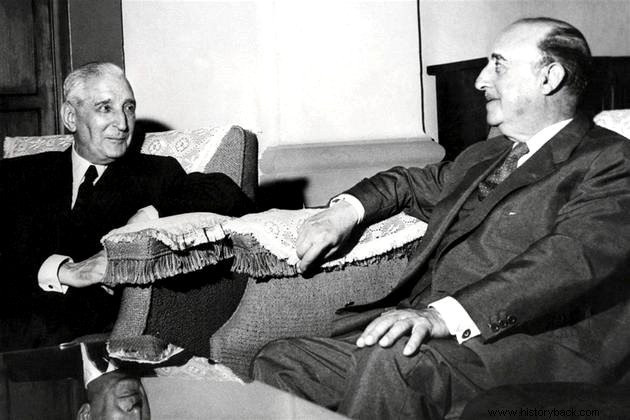The Salazarism is one of the denominations of the Portuguese “New State” (1926-1974), a political regime led by Antônio de Oliveira Salazar (1889-1970).
This ideology was inspired by Italian fascism, Lusitanian integralism and the Social Doctrine of the Church.
Characteristics of Salazarism
The Estado Novo or Salazarism was inaugurated on May 28, 1926, with a coup d'état articulated by the military.
The Estado Novo put an end to liberalism in Portugal and inaugurated a historical period of 41 years of government with fascist aspects such as corporatism and anti-communism.
In these four decades of existence, Salazar was at the head of the government for 35 years. Therefore, the Estado Novo is also called Salazarism.
Its main features are:
- nationalism
- traditionalism
- corporatism
- authoritarianism
- undemocratic
- colonialism
- anti-communism
- anti-parliamentaryism
Policy
During the Estado Novo, the President of the Republic was elected for seven years and he appointed the President of the Council of Ministers. This position was held only by Salazar, until he was removed due to illness.
Salazar centralized the executive and legislative powers and on occasions he accumulated ministries such as the Colonies and the War.
Professional unions and strikes were banned, political parties extinguished, and the one-party model system that established the National Union was implemented.
It is worth mentioning the approach between the Estado Novo and the Catholic Church, which was exempt from paying taxes and guaranteed its space in public education.
 See also:What is dictatorship?
See also:What is dictatorship? Nationalism
As a way of showing the Portuguese and the world, the unity of Portugal was organized at the Portuguese World Exhibition in 1940, in the Belém district of Lisbon.
The idea was to show a large and peaceful country, in the midst of the chaos of the Second World War. Until today it is possible to see some buildings from this event such as the Padrão dos Descobrimentos and the Jardim da Praça do Império.
Likewise, the Portuguese State insisted on maintaining its colonies overseas, despite pressure from the UN and Western powers to vacate African and Asian territories.
However, Salazar and his allies did not heed the calls of the West and only after a bloody war did the African colonies achieve independence.
See also:End of the Portuguese Empire in AfricaRepression
As in all totalitarian regimes, the state built repressive apparatuses to control the population.
There was censorship of the media, where any dissemination of modernity and liberalism was prohibited. Likewise, there was the seizure of books and publications considered subversive.
The political police, called the International and State Defense Police (PIDE), were responsible for the torture and imprisonment that confined political opponents in penal colonies.
Advertisement
The motto of Salazarism was "God, Fatherland, Family " and was disseminated through public education and youth organizations, media and events.
In 1936, the Legião e a Mocidade Portuguesa was created, which brought together children and young people in associations whose objective was to indoctrinate them according to the principles of Salazarism.
The Portuguese Legion still functioned as a paramilitary organization, which guaranteed the system through brutality by rigging elections.
The political propaganda of the Estado Novo was efficient. The name itself is already loaded with propagandistic reasons, as it is intended to instill that the new regime would bring a new era to the country.
Salazar was presented as the ideal leader to direct the course of the nation and his image was everywhere.

Historical Context of Salazarism
In 1910, the monarchy was overthrown in Portugal, giving rise to the “I Portuguese Republic” (1910-1926). This period was marked by profound political instability and the disastrous Portuguese participation in the First World War, which would only worsen this situation.
In turn, the National Revolution of May 28, 1926 inaugurated a period known as the “II Portuguese Republic” or “New State”, where the military took turns in power.
Thus, in 1928, university professor Antônio de Oliveira Salazar is recruited by the military government to command the Ministry of Finance.
During the period he was in this portfolio, Salazar instituted a policy of containing public spending, reducing investments in basic areas and increasing taxes. In this way, he cleaned up the state's accounts and gained more space in a government dominated by the military.
Government of Salazar
With his prestige on the rise, Antônio de Oliveira Salazar was appointed President of the Council of Ministers (head of government) in July 1932.
The following year, the new Constitution was approved, giving full rights to the President of the Council of Ministers, expanding the right to vote for women and granting benefits to the working class such as social housing.
The 1940s were marked by neutrality during World War II. Portugal did not enter the conflict, but ceded military bases to the British and Americans in the Azores.
In the same decade, the Concordat between the Holy See and Portugal is signed. This ensured the separation of State and Church, while securing the political support of Catholics.
Finally, in 1949, the Salazar regime confirmed its anti-communist character, by allying itself with the USA and joining NATO (North Atlantic Treaty Organization).
On the other hand, the 1960s were distinguished by the Portuguese immersion in several colonial wars, especially against the separatist movement in Angola, Cape Verde, Guinea, São Tomé and Príncipe, Timor-Leste and Mozambique.
This fact caused an immense economic and social wear, even more so due to the removal due to illness of the leader Salazar in 1968. He would be replaced by Marcello Caetano (1906-1980) in the same year.
Finally, the Salazar regime was overthrown by the military coup known as the “Carnation Revolution”, on April 25, 1974.
Salazarism and the Carnation Revolution
Salazarism or Estado Novo ended on April 25, 1974, at the hands of soldiers from the Armed Forces Movement (MFA). Without the support of the population due to the hated colonial wars, the regime was increasingly shaky.
The military was responsible for the military coup that conquered Lisbon and other strategic points with popular support.
They occupied the capital peacefully and there were only four dead during the journey that became known as the "Carnation Revolution".
See also:Carnation RevolutionSalazarism and Francoism

While the government of Antônio de Oliveira Salazar was in force in Portugal, a very similar political process was taking place in neighboring Spain.
With the rise of General Francisco Franco (1892-1975), in 1939, a dictatorial regime that would be known as Francoism was installed. This was similar to Salazarism in its anti-democratic, authoritarian, anti-communist and repressive aspect.
Francoism lasted until Franco's death in 1975.
See also:Francoism in Spain Read more :
- Key Features of Totalitarianism
- Totalitarian Regimes in Europe
- Fascism
- Nazism
- Stalinism
